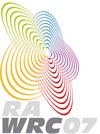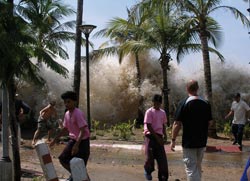
| Home : ITU News magazine | |||||||||||
Bruce Emirali, Radio Frequency Manager, Directorate of CIS Strategy, New ZealandWe have already seen a number of natural disasters in 2007, ranging from floods in Africa to major earthquakes in Peru and Indonesia, typhoons in East Asia and hurricanes in the Caribbean. These events grab the media headlines, dominate the international news and capture the attention of the public. Large-scale catastrophes create human misery, confusion, chaos and widespread economic harm. They happen all too often and they can happen at any time. When disasters occur it is of critical importance that first responders, from both local and international relief agencies, are on the ground and operational in the disaster area as quickly as possible. Speed of effective response is vital in minimizing the human misery and turmoil that always accompany these events. The importance of coordinationCommunications technology has a vital role in ensuring that relief teams can go about their activities as effectively as possible for the benefit of disaster victims. In particular, these teams are heavily reliant on radiocommunication systems. However, getting the best out of high technology-based systems and infrastructure requires national, regional and international cooperation. Responses to large-scale events are likely to involve a large number of relief agencies and relief teams, both national and international, from which arises the critical requirement for interoperability and cooperation, including frequency coordination of radiocommunication systems. In many cases, due to the severity of a disaster and its impact on the local infrastructure, international relief agencies will generally be forced to rely on radiocommunication systems that they bring with them, in order for them to meet the immediate needs of victims. Relief teams coming into a disaster area not only need reliable communications for their own activities to be effective, but also often require the capability of working with personnel from other teams. Harmonized frequency use has been seen as one approach that leads to improved interoperability. Spectrum management is keyWithout proper spectrum management, it is difficult for any organization to use its radio equipment to provide support critical to life, without interfering with local users and any other organization already deployed in the devastated area. Although the critical importance of telecommunications in support of relief operations is well recognized by the United Nations and its Member States, work still needs to be done to ensure reliable communications in support of disaster relief operations. In particular, methods to achieve improved communications within the first 48 hours of a major disaster need urgent attention. Much work has been carried out by the United Nations and by many countries on improving early warning systems, such as for tsunami. While these improvements help to reduce the loss of lives when a disaster strikes, they do not prevent the destruction of local infrastructure and the humanitarian impact that results from this. The immediate requirement for relief operations following disasters generates high demand for reliable communications, which in turn need effective spectrum coordination. The challenge in recent times for ITU, and in particular for world radiocommunication conferences (WRC), has been to put in place regulatory provisions, supported by relevant technical studies, that provide the framework within which the radiocommunication needs of public protection and disaster relief agencies can be satisfied. Following the WRC in 2003, it was strongly recommended that administrations use regionally harmonized radio-frequency bands for public protection and disaster relief to the maximum extent possible, in order to facilitate interoperability between relief agencies. Response of ITUITU’s Radiocommunication Sector (ITU–R), Telecommunication Standardization Sector (ITU–T) and Telecommunication Development Sector (ITU–D) have all worked on disaster communications and their list of accomplishments speaks for itself. These are just a few of them:
In addition, the United Nations Working Group on Emergency Telecommunications (WGET) of the Office for the Coordination of Humanitarian Affairs (OCHA) plays a key role in improving the coordination of emergency telecommunications in support of disaster relief operations. WGET assists in applying the ITU Resolutions and Recommendations related to telecommunications for disaster relief, and is an active facilitator of the promotion and implementation of the Tampere Convention.
Lessons of the tsunamiThe tsunami that hit South-East Asia on 26 December 2004 brought into sharp focus the significance of the work of ITU. It also highlighted some deficiencies in the area of communications support, especially in the initial stages of the relief operations. The follow-up work after the tsunami resulted in a number of regional workshops being held, to share experience and the lessons learnt from coping with the aftermath of this tragic event. Most workshops focused on disaster risk reduction and improving early warning systems. Associated with this was the recognition of the need to enhance communication systems that disseminate early warning information, and to improve the methods used to get this information as quickly as possible to people at risk. However, many of the national debriefing sessions conducted by the operational agencies also highlighted a number of issues related to radio-frequency spectrum in the provision of communications to support disaster relief teams. In examining communication operations after the tsunami in 2004, a number of issues emerged. Although the United Nations established communication networks, these took some time to set up after the tsunami struck. The first 48 hours were critical and considerable communication difficulties were experienced as many international agencies and national teams converged on the area to offer much-needed relief and assistance. The lack, or perceived lack, of a lead agency in planning and implementing spectrum use for communications became clear as various safety-of-life and air traffic communications experienced unavoidable interference. This in turn caused delays in delivering the humanitarian aid that the survivors of the tsunami desperately and urgently required. An initiative by government agencies from Australia, Canada, New Zealand, the United Kingdom and the United States resulted in a discussion paper on this topic being introduced at a meeting chaired by OCHA in May 2007. The meeting concluded that the development of standard operating procedures for spectrum management in the event of disasters would further improve communications, and hence improve coordination amongst humanitarian agencies that are part of the initial response teams. It was also considered that the Director of ITU’s Radiocommunication Bureau could assist Member States with their preparedness for emergency communications. One such activity would be to identify available frequencies for use in emergencies, for inclusion in a database to be developed and maintained by the Bureau. These considerations are currently being studied and are expected to result in concrete actions to be undertaken by ITU and OCHA. The occurrence of disasters cannot be prevented, but their impact can be reduced by preparing appropriate advance operational plans, establishing warning systems, training emergency response personnel, educating citizens about potential dangers and risks, and testing emergency procedures.
|
|||||||||||
 Spectrum management and communications in disaster relief
Spectrum management and communications in disaster relief


